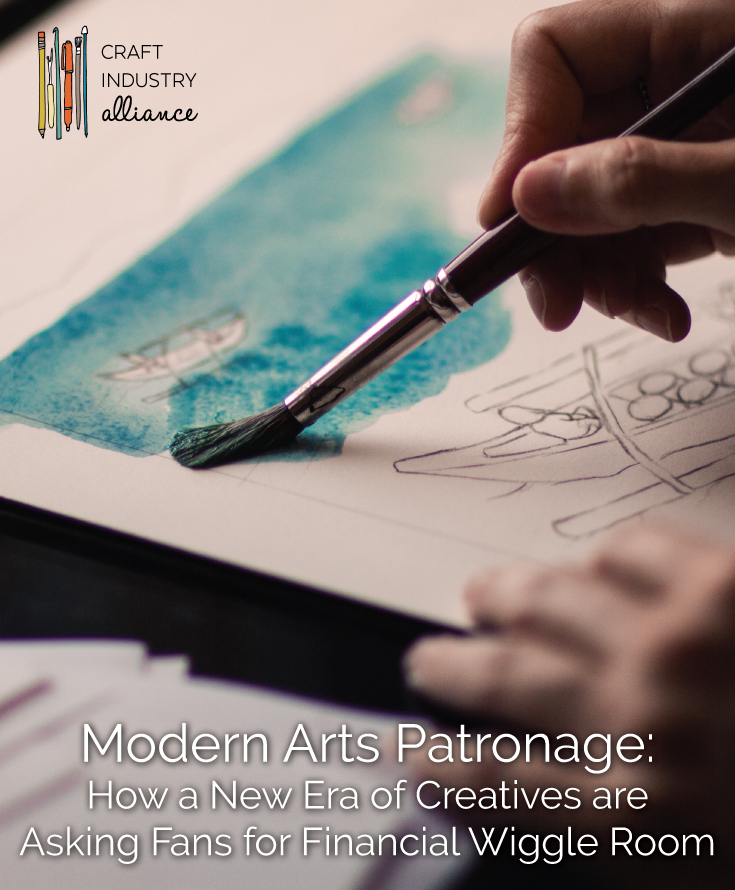
Leonardo had Cosimo de’Medici. Michelangelo had de’Medici and Pope Julius II.
Patrons made the artists….and the artists made some impressive art. For modern makers, crowdfunding is the modern version of a Medici—they hope.
While crowdfunding through online platforms can look like a great way to insulate yourself from market pressures while pursuing a vision, successful campaigns rely on building upon what you’ve already started and treating sponsors as business partners.
Creatives who have won support through platforms like Patreon, IndieGoGo, and GoFundMe say that a casual scroll through the sites can leave the impression that funding campaigns are a great way to build a steady income and a following…just for the asking. But the truth is considerably more pedestrian: creatives are most successful when they use the platforms to win support from current followers for specific projects with clearly outlined results. The longest-lasting value from the platforms is to use them to sharpen marketing and communication skills that drive sustained growth from the actual practice—not to rely on a permanent flow of donations.
It’s not hard to see how aspiring creatives can get the impression of easy money. The home page of Patreon, a for-profit crowdfunding site, sets the expectations clearly: get a “paycheck from your fans,” “have the freedom to create more,” and “give your patrons special stuff.” (Patreon declined to comment for this story.) But what makes Patreon actually work for creatives is when those priorities are reversed: put your customers first and use the platform as a kind of paying, extended focus group. and you’ll gain insights that you can use to build a business that grows on its own merits, not because it’s being subsidized.
Freelance writer Nicole Dieker pays the bills with contract positions like editing for The Billfold, a personal finance website, but she wanted to write a novel and felt she needed the equivalent of a small publishing advance to bring it to fruition. The total of $7,000 she raised via Patreon, from 60 people over 18 months, helped offset some paying work so she could create a block of time to write each week. The financial support of her fan club—which she recruited from her existing base of followers—also became a vote of confidence for her idea and her ability to finish the novel. Dieker released The Biographies of Ordinary People on May 23, after self-publishing and handling promotion and sales herself.
Her supporters got a window into the process of crafting a novel and, of course, a copy of the final product, which sells for $3.99. Dieker met her self-imposed deadline, but reports that it was harder to close down her Patreon page than it was to open it, as Patreon appears to be designed for open-ended support. “I’d use it again but I’d be careful about it,” says Dieker. “It’s easy to think, ‘I want to do something so I’m going to ask everybody for money.’ For me, it should be used sparingly. It’s like a baby or wedding shower: a special circumstance.”
The notion that creatives can immerse themselves in their process and let someone else handle the supposedly dirty work of marketing, selling, and running the business is a pervasive misconception, says Carolyn Edlund, executive director for the Arts Business Institute, which provides professional and business development workshops. These days, she says, people think of crowdfunding sites like agents: a third party that will somehow insulate them from the market.
But the bigger question is, why would any creative want to be insulated from the market?

“Artists who start businesses in isolation are far more likely to fail,” says Edlund. “Those with businesses in a community are more likely to succeed…. Running the business is empowerment that puts you in control and in charge.”
That’s what Indiegogo has discovered. It has been evolving since it launched in 2008, and is now adding a virtual incubator community, says spokesperson Cori Cagide. Having drawn in 8 million donors who have given a total of $1 billion for projects, Indiegogo has learned that the platform is “best used for market validation.”
The first thing creatives need to understand about crowdfunding is how the sites themselves make money: typically by taking a commission from all donations. The underlying technology can be an asset if you need a structure to accelerate your email marketing, branding, and blogging skills and outreach—but you’re still selling, just to an audience that is more inclined to buy on a site specifically geared to donations. And the sites are set up to provide rewards and perks to donors. Instead of collecting money and unveiling a major project, donors expect continual peeks at the work and commentary on the process. That can be more intrusive to the creative process than the real-world cycle of creating in isolation, says Edlund.
Most self-employed creatives envision a thriving practice that supports them and their families, says Margaret Collins, executive director of the Center for Creative Economy, an accelerator for independent creatives. The center offers intensive educational programs designed to boost growth for established creatives, and it is part of a national coalition of consultants to independent creatives.
Crowdfunding is no different from any other types of funding, including winning grants and winning customers, Collins maintains.
“You have to know who your customers are and how you can reach them before you crowdfund,” she says. “Just putting a campaign up is not an answer. You have to have a strategy, develop it, feed it, and market it. You have to work that campaign with the same passion you work your business. What is the value you bring to your customers? What problem are you solving? Why would they buy from you?”
The challenge of articulating an aesthetic goal or a concept is precisely the point, says Collins. Building a following that translates to sustained sales is about understanding what resonates with your core customers and continually engaging with them. “You have to talk with your customers. You can’t just sit in your room and wonder about what they want,” she says. “Then you figure out the essence of why people are connecting with what you do.” It’s the cycle of communicating, listening, learning, and responding that fuels any customer or donor relationship.
Kim Werker, who writes about the creative process and designs adult programs that spark creativity, calls that the ‘rinse-repeat’ cycle of product creation: “It’s hard to figure out what products will work, but I can’t afford to keep experimenting with things that don’t,” she says.
Werker’s Patreon donors support her ongoing experimentation and, in exchange, get a newsletter, podcast, and previews of her work. She is continually building on the 1,800 followers she had when she opened her Patreon page. The few hundred dollars a month she receives from the platform is far from a living income but does provide breathing room — essentially validating the permission she gives herself to pursue open-ended projects. “I’m sharing prototypes with [followers] and they get to see what I’m doing,” she says. “It gives individual creators a way to show the process of the work — that’s something that a lot of people have no window into. People don’t realize what’s involved. It’s an opportunity to inform people and to enable them to enjoy and appreciate the creative process in a different way.”

Joanne Cleaver
contributor
Joanne has been writing about entrepreneurship for 30 years and quilting for 40 years.


I’ve been wondering if I should set up a crowdfunding page. I tried kickstarter a while ago and got nowhere. I think it’s because I didn’t have an established customer base. Now that I have a customer base, I’m left wondering what I could offer people in exchange for their donations. I sell sustainable hand dyed yarn. Sneak peeks into my colorway development? A private Facebook group? This is why I haven’t set up a patreon or indiegogo page.